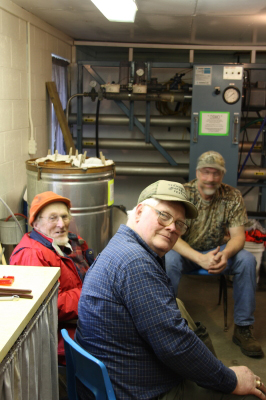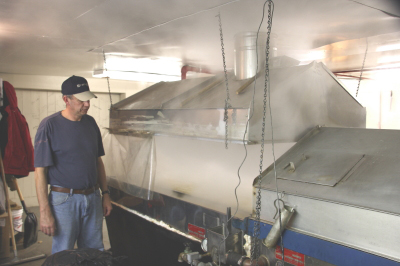
Welcome to Michigan Lakes!
We are all about Michigan lakes. Life on, in and near Michigan's lakefront brings a richness that rewards for a lifetime. Have a story or comments on your experience? You can be one of the first to share it with the world on our Michigan lake directory.
- Error
Roadside
The Snows of Solstice 12/19/08
The view outside is less colorful, and not a pretty one if you plan on driving today.
Either way, whether you’re looking out the window or at my computer screen, what you’ll see right now is a genuine, old-fashioned Michigan winter storm in progress, the kind we used to get as a matter of course back when I was a kid. This one has been heaving pretty much everything into the picture—heavy snow, light snow, frozen fog, freezing rain, sleet, even a couple scatterings of lightning and thunder. If you like variety in your winter weather, today is your box of chocolates.
In the official language of the Grand Rapids National Weather Service…
…WINTER STORM WARNING REMAINS IN EFFECT UNTIL 7 PM EST THISEVENING…HEAVY SNOW WILL TAPER OFF THIS AFTERNOON LEAVING BEHIND FROM 6 TO12 INCHES OF ACCUMULATION. BLOWING AND DRIFTING OF SNOW WILL BE APROBLEM THROUGH EARLY EVENING AS NORTHEAST WINDS INCREASE TO 15TO 25 MPH. WIND GUSTS UP TO 35 MPH WILL BE POSSIBLE. THESE WINDSCOMBINED WITH FALLING SNOW AND SNOW ON THE GROUND WILL REDUCE
VISIBILITIES TO NEAR ZERO AT TIMES.
This is the kind of snow I remember from my boyhood, the kind that makes you think, Yeah, this is Michigan, all right; a real rocko-socko winter storm. And the irony of it is, it’s not even winter. Not yet. This is just autumn’s last gasp, and it’s a doozy, a guarantee that when the winter solstice finally does arrive two days from now on Sunday, it will be as thoroughly white and wintry an event as you could possibly hope for.
Winter is limbering up, doing its stretching exercises in preparation for a good, solid, three-month workout that begins officially, as it does every year, on December 21. Last year we got record-breaking snowfalls; this year seems poised to outstrip 2007. Even as this present storm system winds down later this evening, the next one is already knocking on the door, with more snow in the forecast for solstice.
Solstice. The shortest day and the longest night of the year. With the sun at its southernmost position in the sky, the long slide to winter is at an end and the journey toward spring begins. Here in Caledonia, Michigan, the sun will rise at 8:10 a.m. and set at 5:11 p.m. Eastern Standard Time. We’ll get nine hours and one minute of daylight. But the times and length vary around the state. Down in Niles near the Indiana border, sunrise and sunset occur at 8:09 and 5:17, respectively; in Saginaw, the times are 8:06 and 5:03; in Sault Ste. Marie, 8:18 and 4:53; in Houghton on the Keweenaw Peninsula, 8:38 and 5:37.
This is a day marked by ancient festivals in many cultures, typically inspired by the same thing that gets me to feeling all happy and warm, namely: we’re heading toward spring! From here on, the days grow longer—incrementally, true, but we’re no longer moving toward the year’s darkest day. Now we’re moving toward it’s brightest, and halfway there we’ll greet April with a kiss as she embraces us with warmer breezes, wildflowers, and the return of the songbirds. To be sure, the worst weather still lies ahead. January, February, and March are not user-friendly months. But here in Michigan, we do what we can to make the best of them. A crackling log fire, a pint of rich, amber barleywine, and a snowy view outside the window to make you glad you’re indoors on a day like today…it’s not a bad thing.
Of course, there are also the photo ops that only this time of year can provide. As I’ve mentioned in a previous post, this winter has been a time of discovery for me as a greenhorn photographer. The other day, I took a little jaunt to Alaska Park along the Thornapple River. The day was a gray one, as days in Michigan so often are this time of year, but there at the water’s edge I found a few sights worth capturing. Even at full color, the effect was one of black-and-white, a paradoxical landscape of austerity and gentleness. That’s that nature of winter. It strips the outdoors down to its raw essentials. And that’s just fine. Till springtime warms the land, I’m content to explore the treasures of the ice and snow.
In parting, on behalf of Dave, myself, and Waterland Homes LLC, I’d like to wish you and your loved ones a very blessed Christmas. The times may be troubled, but God is gracious and good.

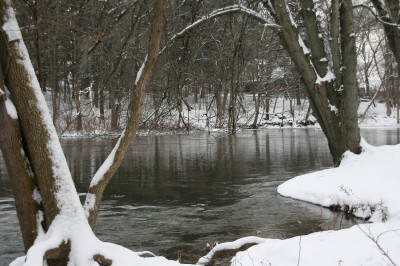

Shear Funnels: When Michigan Weather Does Strange Things jAN 2 09
That”s not entirely impractical, either. Last year, my first storm chase was on January 7. A month later, on February 5, my chase partner and I were back on the road. Both events turned out to be significant tornado outbreaks which reached surprisingly far north. They just weren”t Michigan events.
Michigan most certainly has its share of violent weather, though, and it can come at times when you feel sure that the thunderstorm machine has shut down for the year. Still, most of our big weather occurs from April through June, and then again, more conservatively, around late September through October. Those are the times when moisture, large temperature contrasts with height, jet stream support, and wind shear are likeliest to come together in the finely tuned combination necessary for derechoes, supercells, and tornadoes.
During those times, even if we”re not getting severe weather, every once in a while we casino on-line can get something pretty strange.
One day in the middle of June last year, sitting in my living room recliner, I happened to glance out the sliding glass door to my balcony and did a double-take. Snaking sideways off of a low deck of clouds half a mile away was a perfectly formed shear funnel. There it was—long, sinuous, a beautiful example of what can happen when exactly the right conditions preside. A product of wind shear and condensation near the level of the cloud base, the funnel presented no danger. Not that I”d have wanted to run into it while parasailing, but it lacked the stuff necessary to become a tornado. Its fascination didn”t diminish, though, nor did its aesthetic appeal. You just don”t see one of these babies every day, and this one was a beauty.
The funnel must have existed for a while before I noticed it, and it persisted for a good five minutes or so after—plenty of time for me to grab my camera and snap a few photos. The two images here are the best of the lot. Why am I sharing them with you now, in the middle of the winter? To be frank, because I wanted a break from snow-and-ice photos. Because I thought that you, too, might appreciate something a little different, and shear funnels surely are that. And because I thought you and I could both use a reminder that warmer months lie ahead. They may not be rounding the corner quite yet, but they”re not all that far down the road.
Michigan is not “Big Sky Country” like the American West, but the view here still includes up as well as down. When the snow cover finally melts under the rays of a warmer sun, keep your eyes on the sky as well as the burgeoning countryside. The atmosphere is a landscape in its own right, and sometimes the scenery will surprise you.


The Moods of Winter jAN 9 09
This winter started off in a particularly no-nonsense fashion. Beginning in November and continuing through December, a relentless series of weather systems socked us in with massive amounts of snow. The plows soon had my parking lot rimmed with ten-foot, frozen white piles. But those dwindled to half their size within two days after Christmas, when temperatures in the sixties surged north. Suddenly the concern was no longer icy roads and blowing snow—it was impassible roads and flooded basements. Swollen with rapid snowmelt, streams became torrents, large tracts of fields lay underwater, and area rivers churned over their banks to swallow up untold acres of floodplain. Of course it all froze. Even now, you can drive through the countryside and see icy expanses that lack only skaters to make idyllic ice arenas.
Last Sunday after church, I sallied forth with my camera, intent on getting some shots of the latest mood swing of the season: fog. Above-freezing temperatures and saturated dewpoints had conspired to cloak the landscape in mist, imbuing the most ordinary, unremarkable views with significance and mystery. A tiny lake rimmed by a tamarack bog on the edge of town seemed no longer familiar; the ice and fog had turned it into a composite of Alaskan muskeg and Okefenokee Swamp.
Today, nearly a week later, I am sitting in my living room watching a fine mist of snow drop steadily out of a bland, creamy sky. This is more like it, the kind of stuff I expect this time of year. The snow is collecting on my balcony, covering the top of the parapet like meringue. In a little while, I will leave for Mishawaka to meet a friend, a most unusual friend whom I haven’t seen for several years. It will be good to reconnect with her, but getting there will be a challenge, with a winter weather advisory calling for significant snowfall along the way.
All that can change in a day, though. While a glance at the weather forecast tells me it’s not going to happen, yet at least in theory I could be out tomorrow taking pictures of snowy landscapes transfigured by electric blue skies and a dazzling winter sun; or of pearly patches of ice reflecting sunset colors off of a frozen lake.
Different day, different mood—that’s Michigan in the winter. Not a bad thing, either. Bright days invite a person outside to explore the optimistic trio of snow, ice, and sun. Days like today, on the other hand, give a body every excuse in the world to sit indoors and take one’s comfort with a cup of hot coffee and a good book. Winter is a chocolate box of possibilities. If you don’t like the coconut filling in front of you, never fear—a cherry cordial is bound to come your way.




Heap Big Chilly jAN 16 09
I guess everyone has to do something. Shoot, I’m a storm chaser, so who am I to point fingers. Nevertheless, I can’t help wondering what it is that motivates some guys to hunker down by a tiny hole in the ice for hours at a stretch, particularly on a night like tonight when even the snowmen are wearing down jackets. I mean, January as rule is cold, but when it dips down into the negative digits, we are talking some seriously freezing weather.
Today has been heap big chilly. When the cold goes as deep as it has gone these past twenty-four hours, the quality of the outdoors changes in more than temperature only. Things look different. The snow 
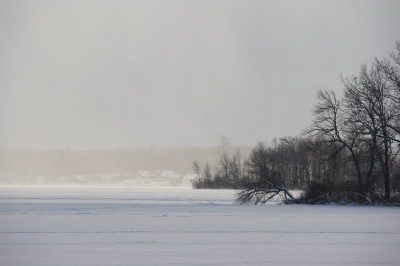

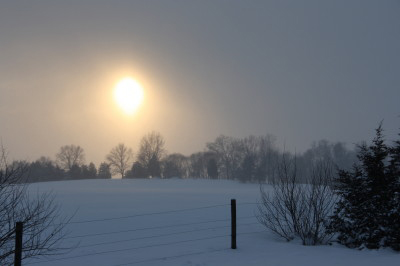 takes on a crystalline appearance, billowing across the landscape in powdery clouds, incandescent in the sunlight. The snow clings to surfaces in a sharply defined way that makes it appear every bit as cold as it actually is. It’s the kind of snow you can hear when you walk on it. You know what I’m talking about—that crunching, squealing sound which comes with temperatures that either make you glad you wore your thermal underwear or else wish that you had. No one in his or her right mind ventures far afield on such a day.
takes on a crystalline appearance, billowing across the landscape in powdery clouds, incandescent in the sunlight. The snow clings to surfaces in a sharply defined way that makes it appear every bit as cold as it actually is. It’s the kind of snow you can hear when you walk on it. You know what I’m talking about—that crunching, squealing sound which comes with temperatures that either make you glad you wore your thermal underwear or else wish that you had. No one in his or her right mind ventures far afield on such a day.
There is one exception: me. I’m glad, too, because doing so today has solved an identity crisis for me. You see, only lunatics and photographers would go to the lengths I went mere hours ago to get a picture, and since I’m pretty sure I’m not a lunatic, that means I must be a photographer. At least, I think I’m becoming one. Considering the alternative, there’s a lot at stake. The learning curve takes time, but I’m enjoying the process, even when the going is bone-zero cold.
Frankly, I’m rather impressed with the pains I took to get what I consider to be the shot of the day. It was one of those landscapes that, once it frames itself in your view, you know you can’t possibly ignore. You’ve got to photograph it. That, at least, was the way I felt when I pulled up to the corner of two country roads this afternoon and encountered a row of trees disappearing into a gray mist of snow.
My first act of He-Man Heroism in obtaining the shot was to pull my car off to the side of the road and actually get out of it. Okay, so maybe that doesn’t sound all that impressive, but if you’ve set foot outside recently, then you know it’s not a bad start.
It gets better. Gathering my courage and setting my face against the wind as my ears began to crystallize, I mounted a snow drift, took another step, and plunged nonchalantly into a ditch. Not a deep ditch. It was over my knees, though, and I was only wearing running shoes. Look, it was a hardship, okay? I’m trying to inject a little drama here. And I kept on going, because by golly, I wanted that shot. The right angle, the right framing, the right distance from the fence in the foreground so that it worked with the composition, not against it…the perfect shot.
I actually took a number of perfect shots. I’m still not sure which one I like best, but the one here is, in my humble opinion, pretty darn good.
If there’s one thing I learned this afternoon, it’s that the best winter photo opportunities are often found on bitterly cold days. I’m not sure what I’m going to do with that bit of knowledge. Chances are, I’ll pursue it further, a thought that scares me just a little. After all, one thing has a way of following another. Next thing I know, I could find myself taking up ice fishing.
Crayola Orange jAN 23 09
Could you use a few mid-winter splashes of color? Me too. A few reminders that, while the Michigan landscape may presently be reduced to white snow, gray ice, and black branches, the arrangement is only a temporary one. Call me an optimist if you will, but I maintain that spring is on the way. A month has passed since the winter solstice, when the long slide into winter ended and our ascent toward rebirth began. Since then, we’ve gained thirty-eight minutes of daylight here in Caledonia. The sun rises five minutes earlier and sets thirty-three minutes later, and perhaps you’ve noticed that the twilight is lingering longer.
So even though it’s still very much winter—in fact, precisely for that reason—I thought I’d take this opportunity to tantalize you with a few reminders of the warmer months that lie ahead. A reminder, for instance, that frozen lakes don’t stay frozen forever. The kingdom of the ice fishing shanty will in due course surrender to the domain of the bass boat. New growth will spring up along shorelines now gripped by ice, and purple loosestrife will cast its arching braids into waters filled with the colors of northern sunsets.
Someday, no longer so terribly far in the future, you’ll wake up to hear a robin calling from a nearby tree. Or perhaps you’ll see him first, hopping across your lawn, patrolling the wet soil in search of earthworms. Autumn’s great migration south will be reversed by spring’s great infiltration north. The marshes will resound with the trill of redwing blackbirds staking out their territory. In the farmlands, gypsy bands of sandhill cranes will rove among the forlorn stubble of last year’s corn. On my deck, as in countless yards across Michigan, the hummingbird feeder will go back up, and the air will once again resound with the whir and thrum of tiny, feisty aerial acrobats vying for position at the nectar dispensers.
During the years when I worked as copy manager for Zondervan, one of my freelance writer had a gift for turning some particularly nice phrases. She once described a pumpkin as “Crayola orange.” I liked that adjective, and I’ve used it ever since, albeit judiciously. Not every orange in nature fits that descriptor. But some almost require it. How much more Crayola orange can you get, for instance, than butterfly weed?
To answer my own question, there is one plant which defines that peculiar, luminous quality of orange-ness for me: the orange fringed orchid, Platanthera ciliaris. With its racemes of brilliant flowers crowding the ends of slender green spires like flocks of tiny, tropical birds, this seldom-seen plant lights the bogs where it grows with its unmistakable presence. From late July through mid-August, the orange fringed orchid puts on a splendid pageant. You’ll be lucky to find a place where the plant grows, but it’s well worth looking for.
The cerulean flash of a bluebird in flight. The emerald jigsaw puzzle of maple leaves. The colors of spring are not so far on the horizon. Meanwhile, winter has colors of her own—muted colors, the pastel pinks and blues of baby clothing. Beauty in the Michigan outdoors is where we choose to find it, and January, like the ice queen in C. S. Lewis’s Chronicles of Narnia, possesses a severe and frosty loveliness. But when the snows and cold become a bit old, it’s good to look ahead to warmer months and brighter colors.
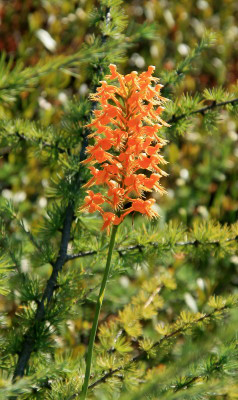
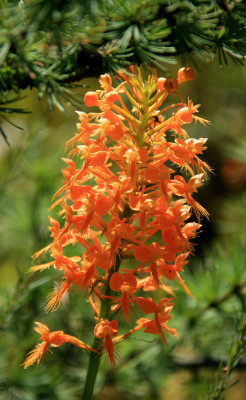

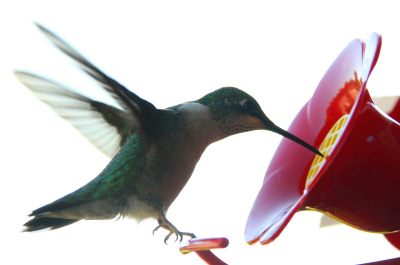
Ice Along the Michigan Coast JAN 30 09
I’m out here at Holland State Park with my friend and fellow storm chaser Kurt Hulst, traversing the jumbled terrain of Lake Michigan’s ice formations. Sunset is closing in rapidly. This will not be a colorful one, though. A gray deck of cirrostratus has robbed the sunlight, reducing land, lake, and sky to a panorama of gray and white. But this is fitting. The ice formations are a study in austere beauty—Old Man Winter’s vast sculpture garden, stretching out along over 400 miles of Lake Michigan coastline from the state line south of New Buffalo north all the way to the Mackinac Bridge.
Though ice builds up along all of the Great Lakes shores, I have a hunch that the formations reach their pinnacle along Michigan’s western coastline. I can’t prove this empirically, but it stands to reason. The formations are a seasonal expression of the same dynamics that produced the spectacular Lake Michigan sand dunes. Blowing across vast stretches of water, prevailing westerly winds build up mighty winter waves that crash against the shore, heaving spray and sand high into the air and lashing them landward. Layer by layer, the wave spray freezes over heaving, buckling chunks of lake ice.
By mid-winter, the result is an otherworldly landscape, stretching a quarter-mile and more from shore and littered with fantastic, alien shapes. Sprinkled with sand and rounded like immense boulders hung with frozen stalactites of ice, the ice sculptures look almost organic in nature—or perhaps molten, like products of volcanism rather than water, sand, and freezing temperatures.
I have been making my way toward the green-banded lighthouse at the end of the pier, but now I step out onto the ice floe in search of photos. The lighthouse itself is a prime subject. Framed among craggy ice shapes, it looks like some strange castle set on a mountaintop.
The ice here is stable, but it can be dangerous to venture too close to open water or into the wrong place on the ice pack. Slip off the ice into the water and there’s no way out. I tread where I can see by the footprints that others have already gone. And for a while, I forget about the cold. Because this place is enchanting, a cross between Antarctica and some mythical world, some frozen Narnia or Tolkienesque vista.
By and by, though, as I snap photos, my fingers grow too numb to ignore any longer. The sun has set, the gray light is receding into darkness, and the cold is growing colder. Kurt, too, looks like he’s finished farther out there on the ice. The time for photos is past—except for one last shot. Big Red, the beautiful, main lighthouse here on Holland Beach, is sending its beam out across the big lake. It just wouldn’t do to leave without getting a shot. And then it’s off to grab dinner and a beer at the Irish pub in downtown Holland.
I will be back, though. I had forgotten how beautiful and remarkable the ice formations are. But today, equipped with a camera to awaken my eyes and stir my imagination, I’ve been reminded. Some bright day, when there is plenty of sunlight to gild the wintry landscape and split itself into jewel-like refractions through the ice, I’ll return to explore another mood of Michigan’s frozen coastline.
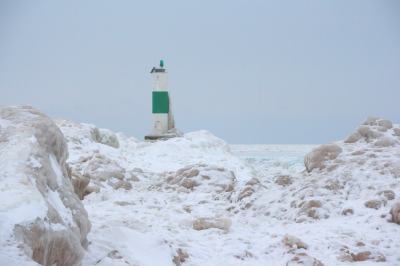
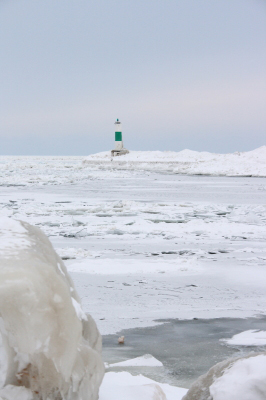


Swans with an Attitude Feb 6 09
But I’ve gotten ahead of myself; let me backpaddle to the other day, Wednesday. It was one of those rare, flawlessly blue midwinter afternoons, with the February sun casting long shadows across the snowscape, and I was in far northeastern Kent County on a photo expedition. I love this part of the county up around Lincoln Lake. A patchwork of lakes, wetlands, woods, orchards, and farmland, it is far from the city and full of appeal for nature lovers and outdoorsmen. For those whose eyes are attuned to the landscape, every backroad here brims with latent epiphanies.
Where one such backroad crossed a stream that wound through a broad, snowy marsh, I pulled aside to take in the panorama. Mute swans were patrolling the waters like miniature gunboats—beautiful birds, as white as the snowbanks that gleamed, resplendent, in the slanting light.
The swans drew my attention from the start, and they quickly became the main show. For maybe ten minutes, I kept my camera trained on a pair cruising the brook on the east side of the road. Eventually they drifted through the conduit and passed to the west side. Aware of me but not alarmed, they continued to paddle placidly back and forth where the current maintained an open channel between brittle crusts of ice.
After a while, a trio farther upstream caught my interest. These guys were busy foraging for submerged vegetation at the bottom of the creek. One by one, they would stick their heads into the water, turn bottoms-up, and rummage around underwater for whatever kind of a meal they were finding at this time of year, aided by those long necks.
As I drew closer, two of the swans went topsy-turvy at the same time, side by side. It was a spectacle as far from swanlike grace as you can get—some might have even called it inelegant—but as a photo op, it was too good to pass up. I grabbed a shot just in time. In another second or two, one of the swans righted itself, and the other followed suite shortly.
No, the swans weren’t intentionally mooning me. They frankly couldn’t have cared less that I was there; they were just going about the business of being swans, enjoying dinner in their inimitable, swanly fashion. But I like my other version of the story better. It has a certain mystique.
After all, not everyone can say he’s experienced a dual-swan mooning. I guess I was just twice blessed.


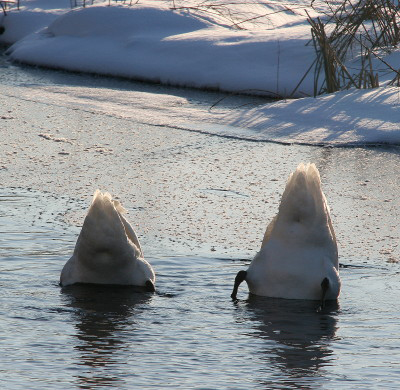
Saginaw Road Trip FEB 13 09
If the Lower Peninsula is shaped like a left-handed mitten, then Lake Huron is a lobster claw clamping onto the thumb of that mitten, and the Saginaw Bay is the claw’s smaller, bottom part. I was standing at lands-edge in a small park along State Road 25 somewhere between Caseville and Port Austin, near the joint of the claw, watching the sun lower toward the silvery sereneness of the bay.
I’ve always had a bit of a Gypsy in me. I suppose it’s got something to do with my Austrian blood, but I’m wired with an innate curiosity that can propel me hundreds of miles in search of what lies over the next hill and around the bend. On this day, I had chosen to observe our nation’s birthday by exploring a part of America with which I was unfamiliar, a part of my own, beloved home state that I hadn’t seen before. I’ve ranged freely throughout the west, central, southeast, and northern parts of Michigan, as well a through much of the Upper Peninsula, but today I planned to finally turn my attention to the vast flatlands of the thumb.
And flatlands they are, the flattest land you’ll find anywhere north of the Illinois prairies. Stretching along the Lake Huron shore from Oscoda down through Bay City and then back up again to Grind Stone City, and inland as far west as Hersey Township, down to south of Howell, and arcing back northeast through Livingston, Oakland, Lapeer, Sanilac, and Huron Counties, the Saginaw Bay watershed occupies nearly 8,700 square miles. Not only is it the largest drainage basin in Michigan, but it’s also the largest contiguous freshwater wetland system in the United States. That means flat. It also means muck farms and other agriculture, and it means great habitat for migrating songbirds and waterfowl along the Mississippi Flyway.
I had no idea how flat, flat really was until I headed east beyond Bay City, and then north toward the shoreline road. That, friends, is some mighty level territory. But it was the lakeshore that I really wanted to see.
Winding my way along State Road 25 past campgrounds and resorts, I found myself in the midst of some very pretty coastal forests. After a long afternoon of driving, I was ready to stretch my legs and get close to the water. A roadside park beckoned, and I pulled in and parked the car. A beautiful, shady little open woods awaited me, with the afternoon sun slanting in from over the lake and casting long shadows on the ground.
I lingered for half an hour by the shore, enjoying the view up and down the coastline and watching the sun slowly descend like a radiant balloon toward the great, shining bay. Then I hopped in my car and began the long journey back home. By the time I reached Flint, darkness had enfolded the land in its warm summer cloak, and fireworks filled the sky in every direction. It was a lovely and colorful ending to an enjoyable day. But in the words of Robert Frost, I still had miles to go before I slept.
The thumb region is, as I’ve mentioned, the part of Michigan that I’m least familiar with, and one I’d like to explore more from an outdoors perspective. Do you know of any nature preserves, state parks, or places in this region that possess outstanding beauty or natural features? If so, I’d love your suggestions. Please drop a note in the comments section and tell me where in the thumb area you would visit next time around if you were me.
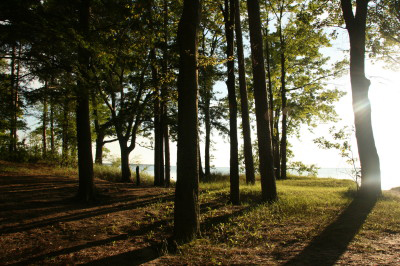


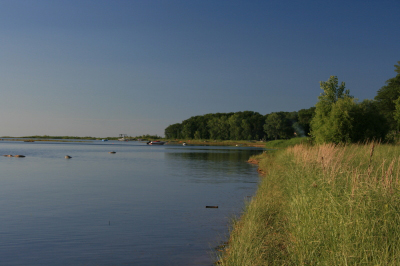

Charlton Park FEB 20 09
From fishing, to photography, to birding, to family outings, to Michigan history and more, Charlton Park offers something for just about everyone. Even cabins in the woods for winter wanderers like me looking for something a little different with which to fill their camera lenses.
The cabin called for exploration, and naturally I responded. I have no idea what its history is. It could be a relatively recent reconstruction, but given its weatherbeaten appearance and its location a few hundred yards up a wooded slope from a historic community, it’s reasonable to assume that the old structure is an original pioneer dwelling. The raised foundation suggests that it may have been moved from somewhere nearby to where it now stands. Or maybe not. I didn’t find any mention of it in the Charlton Park website, so the story behind it remains a mystery. What’s plain to see, though, is that the cabin is remarkably well constructed, a very sturdy-looking log dwelling dovetailed together with amazing precision.
Sundry items on the premises add to the sense of human presence—a shed for firewood on the northwest side; a rustic, picturesque rain barrel up against the east wall. The grounds, if not the cabin itself, appear to be used for something—school groups, Boy Scout outings, who knows?
Leaving the cabin, I hopped in my car and continued down the road toward the park office and the historic village. Originally known as Indian Landing, the town was once a thriving nineteenth century community, and today it is preserved as a landmark jam packed with fascinating insights into life in an 1800’s Michigan settlement. Look through the website and you’ll be amazed at what this park has to offer in the way of educational programs, events, volunteer opportunities, forestry, and recreation. Charlton Park is a class act and one of the true jewels of Barry County, Michigan.
Today, however, with a cold northwest wind blowing snow across the empty parking lot, you’d have had to use your imagination to picture the place filled with people strolling down tree-shaded walks past the Bristol Inn, the cooper’s shop, the blacksmith shop, the one-room schoolhouse, and so forth.
On a rise overlooking the rest of the village stands the Carlton Center Church. My hands were growing numb, but the lovely, white building with its picturesque steeple was too photogenic to pass up. Built in 1885, the structure served as a Methodist Episcopal church until 1975, when it was moved from its original location in Carlton Center to Charlton Park. Complete with all of its original furnishings, the church is still used today for weddings—and as a subject for wayfaring writers bearing cameras.
If you think of Barry County as little more than a hinterland of lakes, wetlands, farms, and state game land, then a visit to Charlton Park will change your mind. Whether you want to experience a cross-section of Michigan history, picnic in a pavilion, or simply relax with a book beneath a shady maple by the riverside, treat yourself to an afternoon at the park. Bring your family, your date, or just yourself. You’ll thank yourself for taking you there.

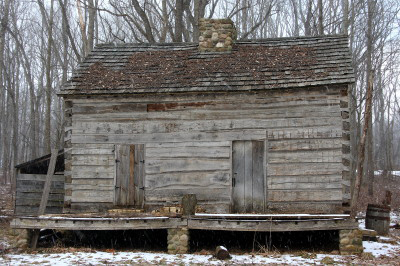

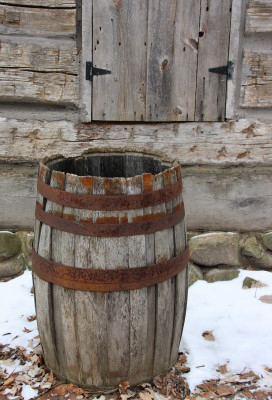
Along the Thornapple River fEB 27 09
It takes thirty-five gallons of maple sap to make one gallon of maple sugar. That’s not the only thing I learned from Steve Hays at Maple Manor, but it’s one tidbit of insight I picked up when I stopped by his maple sugar refinery in Vermontville, Michigan. There’s more to tell, but I’m saving that for a different blog. I’m mentioning this just to whet your appetite, in the manner that one piece of maple sugar candy makes your mouth water for another piece.
I came across Maple Manor by pure serendipity while out exploring the upper Thornapple River. My goal on this last day of February, 2009, was to find the headwaters southeast of Charlotte. I didn’t succeed, but I had a wonderful afternoon, and if I’d had another hour of daylight and a county map instead of a state map, I’m sure I’d have found what I was looking for.
The Thornapple is, in my humble opinion, the most beautiful river in southwest Michigan. All rivers have their lovely stretches, but the Thornapple has more of them than any other river I’m aware of in this part of the state. It’s a clean river, untainted by industry, flowing through mostly rural settings and just a handful of town on its journey from the south central part of the state to its junction with the Grand River in Ada.
I’m familiar with the Thornapple as far east as Charlton Park, where it broadens out into Thornapple Lake. From that point on, I’m in personally uncharted territory. Today, I decided to acquaint myself with the upper half.
Just north of the bridge in Nashville, the first road east takes you for a winding journey right along the riverside for maybe a mile-and-a-half before curving to the north. A fleet of swans—scores of them, perhaps hundreds—call this area home. The swans were patrolling the waters in company with a multitude of Canadian geese, the weed birds of the North.
Farther east, down a muddy country road, I caught up with the Thornapple again. But it was a wilder version of the broad backwaters in Nashville. It had narrowed down to a wide, ice-fringed ribbon bordered by cattail marshes and forested hillsides. I stopped to snap a few photos under the late afternoon sun. The day, which had begun with bands of cloud and a light sprinkle of snow, had transitioned into a flawless blue mirrored in the river’s serene surface.
Down the road a few more miles lay Vermontville. When you draw near the town this time of year, you’re apt to see steam rising from local maple sap refineries. These aren’t big, commercial businesses; they’re down-on-the-farm, family-run operations, bastions of Vermontville’s treasure, real maple sugar and maple syrup.
Impulsively, I stopped in at Maple Manor, purchased a half-gallon of syrup and a sampler of candy, and talked with the crew, who were sitting around the boiler. But as I’ve said, that’s a separate blog, so stay tuned.
Twenty minutes later, I was back on the road and headed for Charlotte. Southeast of town, along the backroads, I once again crossed the Thornapple. But it was nothing like the broad channel that flows through Middleville, and Caledonia, and Alaska, and Cascade. Here, in the midst of farm country and lowlands, a narrow stream threaded through a tangled, swampy woods. The sun’s last rays slanted through tree silhouettes, glinting orange off of icy banks.
The day had wound to a close, and I, too, was winding down. I snapped one last picture. Then, climbing back inside my car, I commenced the long drive home.

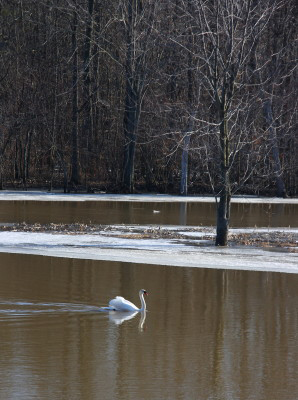
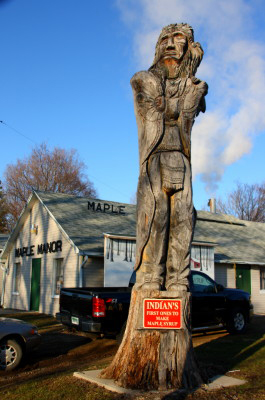
Along the Thornapple River fEB 27 09
It takes thirty-five gallons of maple sap to make one gallon of maple sugar. That’s not the only thing I learned from Steve Hays at Maple Manor, but it’s one tidbit of insight I picked up when I stopped by his maple sugar refinery in Vermontville, Michigan. There’s more to tell, but I’m saving that for a different blog. I’m mentioning this just to whet your appetite, in the manner that one piece of maple sugar candy makes your mouth water for another piece.
I came across Maple Manor by pure serendipity while out exploring the upper Thornapple River. My goal on this last day of February, 2009, was to find the headwaters southeast of Charlotte. I didn’t succeed, but I had a wonderful afternoon, and if I’d had another hour of daylight and a county map instead of a state map, I’m sure I’d have found what I was looking for.
The Thornapple is, in my humble opinion, the most beautiful river in southwest Michigan. All rivers have their lovely stretches, but the Thornapple has more of them than any other river I’m aware of in this part of the state. It’s a clean river, untainted by industry, flowing through mostly rural settings and just a handful of town on its journey from the south central part of the state to its junction with the Grand River in Ada.
I’m familiar with the Thornapple as far east as Charlton Park, where it broadens out into Thornapple Lake. From that point on, I’m in personally uncharted territory. Today, I decided to acquaint myself with the upper half.
Just north of the bridge in Nashville, the first road east takes you for a winding journey right along the riverside for maybe a mile-and-a-half before curving to the north. A fleet of swans—scores of them, perhaps hundreds—call this area home. The swans were patrolling the waters in company with a multitude of Canadian geese, the weed birds of the North.
Farther east, down a muddy country road, I caught up with the Thornapple again. But it was a wilder version of the broad backwaters in Nashville. It had narrowed down to a wide, ice-fringed ribbon bordered by cattail marshes and forested hillsides. I stopped to snap a few photos under the late afternoon sun. The day, which had begun with bands of cloud and a light sprinkle of snow, had transitioned into a flawless blue mirrored in the river’s serene surface.
Down the road a few more miles lay Vermontville. When you draw near the town this time of year, you’re apt to see steam rising from local maple sap refineries. These aren’t big, commercial businesses; they’re down-on-the-farm, family-run operations, bastions of Vermontville’s treasure, real maple sugar and maple syrup.
Impulsively, I stopped in at Maple Manor, purchased a half-gallon of syrup and a sampler of candy, and talked with the crew, who were sitting around the boiler. But as I’ve said, that’s a separate blog, so stay tuned.
Twenty minutes later, I was back on the road and headed for Charlotte. Southeast of town, along the backroads, I once again crossed the Thornapple. But it was nothing like the broad channel that flows through Middleville, and Caledonia, and Alaska, and Cascade. Here, in the midst of farm country and lowlands, a narrow stream threaded through a tangled, swampy woods. The sun’s last rays slanted through tree silhouettes, glinting orange off of icy banks.
The day had wound to a close, and I, too, was winding down. I snapped one last picture. Then, climbing back inside my car, I commenced the long drive home.



Michigan On Ice March 6 09
Granted, ice is not normally the most compelling subject. I mean, in March, there is plenty of the stuff to be had, and here in Michigan we’re kind of eager for it to go away, right?
But this winter, the flooding produced by massive snowmelts followed by deep freezes has left us with entire landscapes that have been defined by ice. Not just lakes and rivers, but also acre upon glossy, glass-like acre of fields and forests, transformed into works of icy art.
At Pickerel Lake Park near Grattan Township in east-central Kent County, arctic winds have scoured the icy surface of the lake. You can find the same phenomenon all across Michigan: countless lakes frozen into vast, snowless mirrors reflecting the color of the sky above.
I ventured out onto the boardwalk to take a few photos of that looking-glass ice, shining glacial blue beneath the azure of the clear, late afternoon. I had an idea that I would continue from there to hike the trails and see what I could see. Pickerel Lake is a beautiful park and well worth exploring any time of year. But I hadn’t reckoned on how cold it was. The same frigid wind that had so effectively swept the snows off of the lake was now very quickly sucking the heat out of my hands. You’d think that by now I’d remember to wear gloves, but no, that lesson just doesn’t seem to penetrate, and it’s darned hard to take pictures when your fingers are numb to the bone. So I finally turned back, hopped in my car, and headed east.
Right about the time that my fingers were regaining feeling, it was time to pull off the road and take more pictures. A stand of roadside trees had grabbed my attention—or, more accurately, their present setting had caught my eye and required my response. So much of our appreciation of the natural world lies in exactly that: how we respond to it. Will we step off the treadmill of the day’s preoccupations when a moment beckons, long enough to slow down inside and look—really look, with all of our senses and our heart—at the beauty that surrounds us? Because that beauty is everywhere: a knobbly old oak; the linear silhouettes of reeds mirrored in lake water; the ratcheting of sandhill cranes from out over the marshes; a rosy sunset casting long shadows across a river valley; the scent of honey locusts filling the late spring evening.
Or a frozen, wintry grove glorified by the afternoon sun.
At one time, the road where I was parked had clearly been underwater. Remnants of the original ice field, clinging to the tree trunks, now stood transfixed by the light, gleaming like glass shelves and crystal plates suspended above the present, icy surface. It was an amazing and beautiful sight, and I did my best to capture it with my camera.
In this last, rather abstract-looking photo, if you look closely, you’ll notice that the right side of it shows a thin plate of ice suspended on a branch. You can see right through that plate, just like you would through a pane of glass, to the newer ice below. And no, that’s not water splashing around the branch. It’s all ice, nothing but ice.
And for all I know, with the temperatures steadily rising these past few days and on into the weekend, that ice may be gone by now. If it’s not, it will be shortly. Today’s treasures dissipate in tomorrow’s sunlight—true of winter, and true of life.
I’m glad I took a little time to capture some memories.


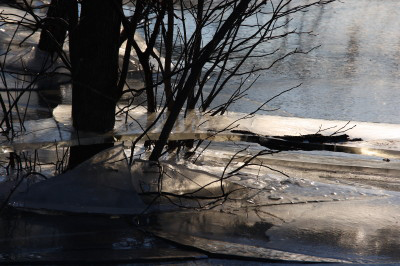

Maple Sugar Time March 13 09
The Algonquin Indians were the first to tap the sugar maple and black maple trees. A couple swift tomahawk blows to the trunk produced a V-shaped notch, into which the Native Americans inserted a reed or sluice of bark which channeled the sap into birch bark buckets. The Indians concentrated the sweet liquid slightly by throwing heated stones into the buckets, or by simply allowing the sap to sit in the cold air overnight and then scraping the ice off the surface the next day.
The pioneers took the process further, collecting large quantities of the sap and boiling it down into a syrup. The approach remained unchanged for three centuries, and even with the time-saving refinements of modern technology, it still consists of the same simple, raw essentials as back in the early 1700s: tap a bunch of maple trees, collect the sap in buckets, and boil it till it’s thick. Just make sure you get lots of sap. It takes thirty-five to forty gallons of maple sap to produce a single gallon of maple syrup.
In Vermontville, Michigan, the crew at Maple Manor begin tapping the trees right after Valentine’s Day. Located smack in the heart of the village, Maple Manor is just one of a number of local sugar shacks that give Vermontville its longstanding reputation as “Home of the Maple Syrup Festival.” Now in its sixty-ninth year, the festival—held in 2009 from April 24–26—is a celebration of all things maple.
Maple Manor is the festival’s headquarters, and it’s a fitting base of operations. Run by Steve Hays, the Manor is a quintessential sugar shack with a cloud of steam chuffing from the chimney outside, and a boiler on the inside plus a gang of friends to sit around it, shooting the breeze while Steve tends the syrup. The conviviality is as tangible as the smell of maple, and that’s as it should be. From its very beginning, maple syrup making has been about family and friends as well as syrup.
I dropped by Maple Manor on impulse a couple weekends ago while out on a drive. I stepped inside with an inquiring mind and left with a quart of fresh syrup, a sampler of maple candy, and a fresh appreciation for a tradition as old as America itself.
In my family there is a painting by an artist and friend of my father’s named William Blackmun. It was my dad’s favorite work by Bill, so much so that Mom bought it for Dad as a birthday gift many years ago. The painting is titled, “Maple Sugar Time.,” and it depicts a sugar bush, complete with a sugar shack in full operation, somewhere in the backwoods outside of Niles, Michigan.
My father has been gone for two decades now, but the painting lives on. I think Steve Hays and the gang at Maple Manor would appreciate it, and I’m certain that Dad would have liked them. They’re doing far more than manufacturing lip-smacking maple syrup. They’re keeping alive a centuries-old craft—rooted in the hardwood forests and steeped in history—that adds color and flavor, lots of flavor, to this remarkable state called Michigan.


